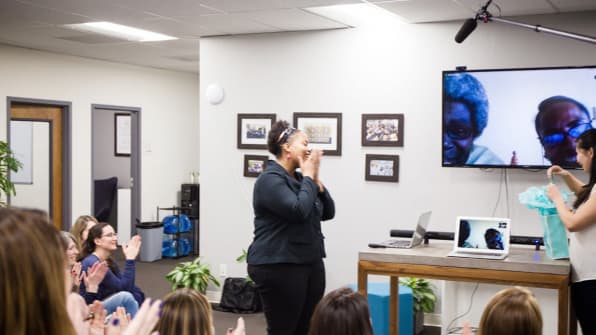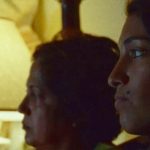How This Medical Student Brought DNA Testing To Women In Trinidad and Tobago
Gerneiva Parkinson grew up in Trinidad and Tobago, a Caribbean nation off the coast of Venezuela known for its mangrove swamps and lush rainforests. But for Parkinson and many other young women, island life had a dark side.
Throughout her childhood, Parkinson’s friends’ mothers and other women in the community were mysteriously getting sick in their thirties and forties. The diagnosis, as she later learned, was breast cancer. “These are women with young children dying in their prime, but it’s common in Trinidad,” she tells me. “Infectious disease is well-studied, but cancer was, and still is, very taboo.”
I met Parkinson at the headquarters of Color Genomics, a Silicon Valley-based startup founded by former Google and Twitter executives. Parkinson was invited to the company’s offices to deliver a presentation on the high rates of breast cancer in her home country, and her journey to understand the roots of the disease. “When it came to cancer, it has been really hard to get answers, even as a biology student,” Parkinson explained to the team.
Color Genomics is one of a growing number of U.S. companies that leverage DNA sequencing to answer a wide variety of questions about disease. The price of such technologies have dropped significantly over the past few decades. In 2001, it cost $100 million to sequence a human genome. Today, Color offers one of the cheapest offerings on the market, with a test to screen for a set of genes associated with hereditary cancers for just $249.

Thus far, this kind of technology is still limited to the wealthiest nations, such as the U.S. and European countries, where testing is common among those with a family history of cancer or an early diagnosis. “In the U.S., screening has really been incorporated into routine care for breast cancer,” says Erin Hofstatter, a medical oncologist based in New Haven, Connecticut. The presence of the gene mutation is by no means a death sentence. Many informed patients seek highly effective preventative treatments to reduce the likelihood that they’ll ever get sick.
For the most part, these screening tools have not reached Trinidad and Tobago. Few women in the country get tested for known cancer mutations due to the lack of awareness among doctors and patients, as well as the high price of tests. Parkinson realized a few years ago that before she could push the local Ministry of Health to change that, she needed hard data. At that point, Parkinson–who was still a medical student–took the unusual step of creating a study of her own.
Bootstrapped Research
Well before she made the connection with Color Genomics, Parkinson was awarded a research fellowship with a small amount of funding to study the breast cancer problem in Trinidad. After going door to door, she was able to raise additional capital from her parents and a handful of small local businesses. The target initially was to test 350 women, but Parkinson only had enough to pay for 60.
Still, she moved ahead with her goal to recruit a sample set of breast cancer patients from diverse backgrounds. Trinidad’s ethnic makeup is divided into three main categories: Those with African heritage, who were descended from slaves; East Indians, whose ancestors were laborers from the Indian subcontinent; and people of European descent.
After successfully testing the first cohort, she and Hofstatter nervously awaited the results. Both were expecting that the gene mutations would be found in no more than five patients, and that the results could be delivered ad hoc via phone. In the U.S., Hofstatter tells me, the prevalence rate is about 5% to 10%, and studies typically involve thousands of patients.
“When the results came back with 15 patients, I was like, ‘Oh my God, that’s 25%,” recalls Hofstatter. The researchers also discovered that it was more than just one or two gene mutations. Hofstatter immediately agreed to fly out to the country to speak to the study participants in person.
Parkinson knew that more extensive research would be necessary to convince the government to routinely pay for screening, and contacted Color Genomics to inquire about its affordable tests. The company’s head of research, Alicia Zhou, recalls being impressed with Parkinson’s efforts: “She was a medical student taking on the burden of a country.”
The Color Genomics founders agreed to fly out a few team members, including Zhou, to meet with locals and better understand the challenges. “The objective for us all along was to format a study that could be used to lay the groundwork for future testing,” Parkinson explains.

Next Steps
For Color Genomics, the partnership offered an opportunity to expand genetic testing around the world. After the trip to Trinidad, the company awarded Parkinson its first research grant for $62,500 (the price of 250 tests) and volunteered its own genetic counselors to train local physicians. I was invited to watch as Parkinson received her award, as her parents tuned in via Skype.
Parkinson is well aware that the tasks ahead won’t be quick or easy. The infrastructure that is required to move the country from a system of treatment to prevention includes access to genetic counselors; breast MRIs; reimbursement for preemptive mastectomies; funding for public health campaigns; education for primary care doctors; and more. Parkinson is also hoping to fund studies into other forms of cancer, including prostate cancer, which are also more prevalent in the islands than in most areas.
In the final moments of our meeting, I ask Parkinson and Zhou a nagging question that’s been on my mind since I first heard about the breast cancer rates in Trinidad: “Why?” Both have theories, but no conclusive answers.
It’s possible that there’s an environmental cause, although that would require further public health research. As Zhou explains, there also doesn’t appear to be a single “founder effect,” a term that refers to the loss of genetic variation that occurs when a new population is established by a small number of individuals from a larger population. Instead, the answer might be related to the ethnic diversity from decades of colonial rule: Tobago changed hands more frequently between 1650 and 1814 than any other Caribbean territory.
“I think with the influx of the French and the Spanish and the Africans, these mutations happened and they never left the population,” Hofstatter later explained to me by phone. Trinidad and Tobago is a small and relatively isolated country, which makes it harder for the mutation to randomly disappear within a family. “Once you introduce a mutation, it’s really hard to get rid of it.”
Fast Company , Read Full Story
(54)














